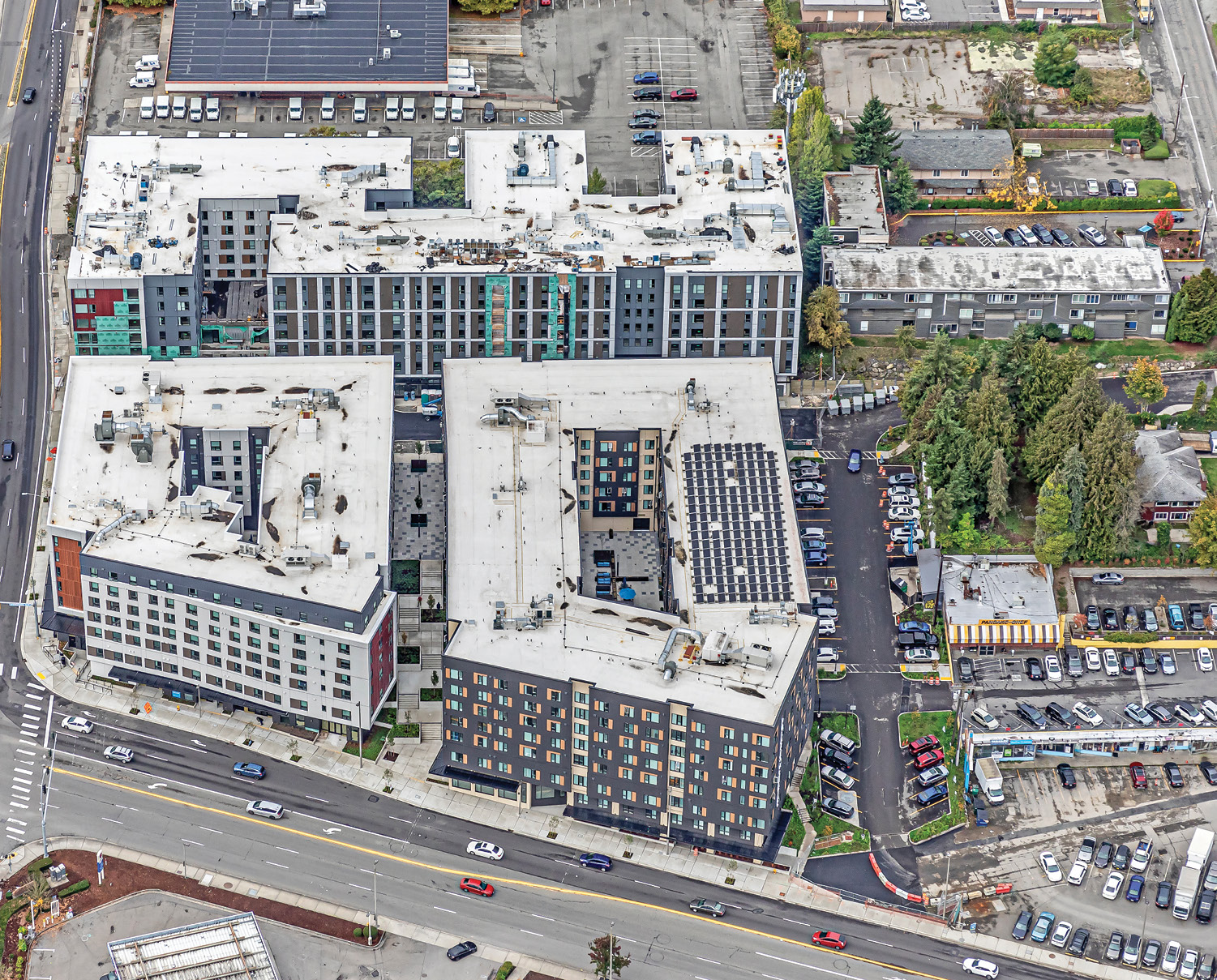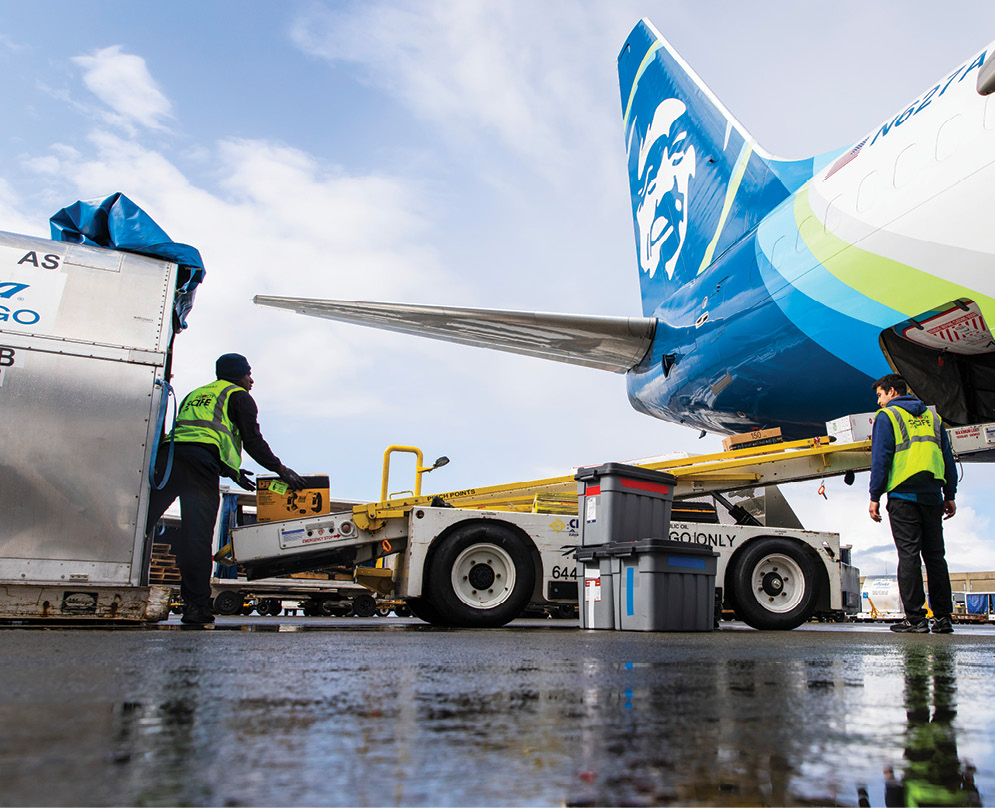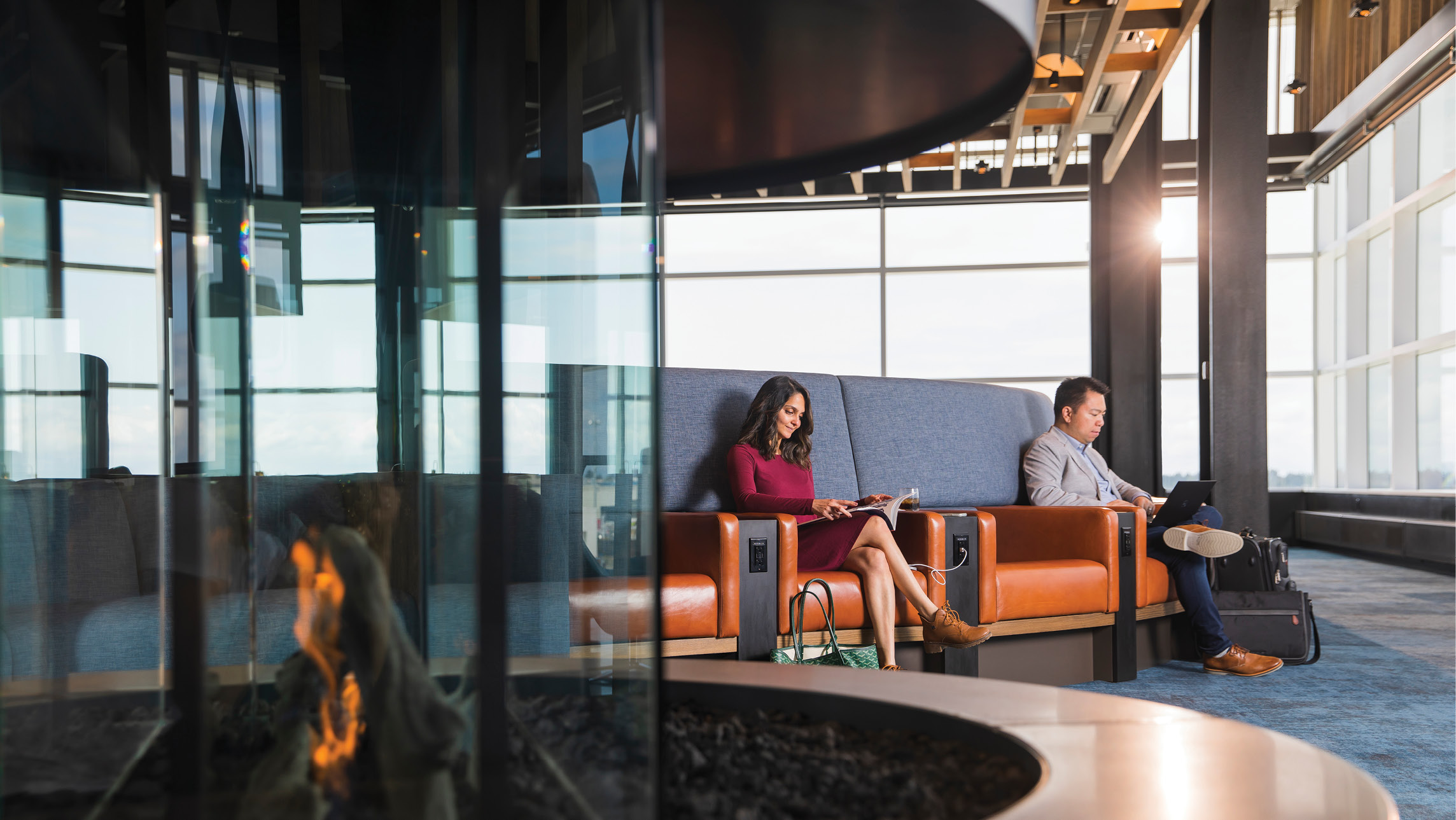As a commercial real estate developer and investor, Pat Callahan is a risk-taker by nature. But that doesn’t mean he’s willing to tempt fate when it comes to running his business, Seattle-based Urban Renaissance Group (URG).
Nine years ago, URG placed a calculated bet when it acquired an under-performing office complex in SeaTac, the up-and-coming Seattle suburb that surrounds Seattle-Tacoma International Airport (SEA) and serves as the headquarters to Alaska Airlines.
With the airport undergoing a surge of expansion, Callahan says URG timed its investment to leverage changing lifestyle trends and, crucially, to the completion of SeaTac’s southernmost of three light rail stations. Those three emerging hubs of transit-oriented development — at Tukwila International Boulevard Station, at SeaTac/Airport Station and at Angle Lake Station — serve to connect SeaTac to the booming regional landscape.
“Having the light rail link to Seattle was really the key point in us acquiring that asset in SeaTac,” Callahan tells Site Selection. “You have tenants being priced out of downtown Seattle and Bellevue who are in need of a good, transit-accessible location. Being in SeaTac, we can provide that. And being next to the airport, obviously, is a crucial selling point.”
URG’s bet turned into a winner. With a nudge, Callahan says, from some “tender loving care,” occupancy at the 582,000 sq. ft. International Place, previously known as the SeaTac Office Center, has grown from 62% at the time of purchase to more than 90% today.
HVAC contractor MacDonald-Miller is among the growing list of new tenants, having relocated its corporate headquarters to the campus’s north tower in August 2022. It now occupies 45,000 sq. ft. on the 6th and 7th floors as well as 5,000 sq. ft. on the ground floor, which has been transformed into an MLAB — a virtual reality space where customers can experience MacDonald-Miller’s mechanical systems.
“We really wanted to be centrally located and easily accessible, between the I-5 corridor and near public transportation. So, the fact that the airport and the light rail are right here was a huge factor,” says Amanda Spraker, MacDonald-Miller’s chief administrative officer. “And then, you know, the city itself, with the tax incentives and the cost effectiveness of SeaTac over the city of Seattle. It’s more affordable in SeaTac and yet, we’re three minutes to the freeway and 10 minutes to downtown Seattle. The best of both worlds.”
MacDonald-Miller currently boasts 1600 employees throughout the region, 350 of which are located in the SeaTac area.
“We did a pretty extensive demographic look at the zip codes and whatnot of our current staff prior to being down here, and one of the things that we found was that we already have a lot of existing staff that call the south end their home. So many of us live in SeaTac or around the city, and some smaller communities, Burien and Normandy Park, are all right next door.”
SeaTac’s zeal for growth is fueled not merely by aspiration, but by a long-term strategy to maximize its unique collection of assets, which includes six Opportunity Zones that cover two-thirds of the city. SeaTac, Washington State, Sound Transit and the Port of Seattle are in the process of delivering more than $10 billion in capital improvements, including light rail extensions that will soon offer connections to the bustling hubs of Bellevue and Redmond to the north, and Tacoma to the south.
Trent Mummery, founder of Trent Development, a Seattle-based real estate development firm specializing in multifamily and mixed-use projects, believes that with the expansion of this resource, SeaTac is ushering in a new era of economic growth.
“It’s no longer going to be at the end of the line,” says Mummery. “As the light rail expands to Federal Way Station, which is opening up in a year, you’ll be able to go south to the other colleges, to other job opportunities, pretty easily. And then, when Jenkins Park opens in a year, you’re going to have the ability go east quite quickly, from SeaTac to the East West Connector. So, it’s a great centrally located opportunity for people that want to move north, south or east. It’s pretty hard to be any closer than one light rail station away.”
Sea-Tac International Airport Drives Economic Momentum
Incorporated as a city only in 1990, SeaTac has a resident population of 32,000 that, with travelers and visitors, swells to 170,000 by day. With its modest size (10 sq. miles) and lofty aspirations, it might be likened to the ambitious young buck who profits from having older brothers who command sway in the neighborhood.
Big brother No. 1, Seattle, is a 15-minute shot up Interstate 5 and boasts a posse that includes the likes of Amazon, Microsoft and Costco.
Big brother No. 2, Sea-Tac International (note the hyphen that the city doesn’t share), delivers the world to SeaTac’s front door. Operated by the Port of Seattle, it is the nation’s eleventh busiest airport, serving nearly 46 million people in 2022. In the wake of the pandemic, the airport has been quick to recover, with this year’s total number of passengers expected to be slightly shy of 2019’s traveler volume, 52 million. From June to August 2023 alone, approximately 15.3 million people traveled through the airport. Its 33 airlines connect to 92 non-stop domestic and 28 international locations.
Why SeaTac for HQ?
Central Location in the Pacific Northwest
•
$10.5 billion in new capital investment
•
Eleventh busiest international airport
•
Light rail connection to Seattle/ University of Washington
•
Transit-connected housing
•
Available land at affordable prices
•
Opportunity Zones
•
Business-friendly environment
The airport’s current five-year expansion devotes $3.7 billion to more than 100 projects, some of the most prominent being an underground baggage handling system and a concourse expansion that’s adding eight new gates, new restaurants and an Alaska Airlines lounge that offers spectacular views of the Olympic Mountains and downtown Seattle. Nineteen more new gates are envisioned by 2027.
Of these projects, a brand new, nearly $1 billion International Arrivals Facility (IAF) has already been completed. With this expansion, the airport has more than doubled its passenger capacity, added eight new international-capable gates and incorporated enhanced technologies to maximize efficiency.
Since 2020, SEA has announced 13 new international services including upcoming routes to Nassau, Bahamas, serviced by Alaska Airlines starting in December, and Munich, Germany, serviced by Lufthansa, beginning May 30, 2024.
“The airport propels what is a very strong hospitality sector” says Dave McFadden, managing director of the Port of Seattle’s economic development division. “It supports a tremendous amount of economic activity within the city limits. The lion’s share of offsite parking, hotels and support facilities are located within SeaTac.”
A pedestrian bridge over busy International Boulevard places the airport within an easy walk of SeaTac’s large-scale Hilton and Marriott facilities that offer a combined 60,000 sq. ft. of meeting space. The renowned Cedarbrook Lodge, a converted Washington Mutual training center, is a short distance away. Those types of amenities, suggests Matthew Behrens, capital markets manager for CBRE, deliver significant value to office and headquarters operations.
“You have really good properties that can host events where you fly your people in from other locations and they can meet right there by the airport. They’re not fighting traffic. It’s all very efficient.”
Adjacent to the airport, construction is currently underway on a six-story 198-room hotel. Located on International Boulevard, the almost 3-acre property this project occupies will also feature a seven-story, 182-unit apartment complex.

Inland Group is close to completing the SeaTac Centre Redevelopment, a mixed-use project near Tukwila Station.
Photo Courtesy of Inland Group
Recent additions such as this have pushed SeaTac’s hotel capacity to more than 6,000 rooms, with another 1,000 planned. The hospitality market’s evolution, Behrens believes, reflects SeaTac’s maturation.
“What we’re seeing,” says Behrens, “is more of that select-serve, upper-scale product coming to SeaTac. That’s a good indicator.”
Alaska Airlines Expands SeaTac Headquarters
No corporate enterprise better illustrates SeaTac’s upward trajectory than Alaska Airlines. To accommodate a growing workforce, Alaska in 2020 built out the first phase of the “Hub,” a $32 million expansion to its headquarters just south of Sea-Tac International. The most prolific airline serving the West Coast, Alaska says that in the last eight years, its employee base has grown by 76%. The expansion is viewed as a long-term commitment to the airline’s hometown.
“With its ideal location, SeaTac City can attract educated and diverse employees from the north, south, and east, which makes it perfectly situated for our company headquarters.” says Shane Jones, Alaska’s vice president for real estate and business development.
“SeaTac also benefits from housing that is more affordable, both inside SeaTac city limits and in surrounding communities, than the region as a whole,” says Jones. “I think any industry and sector would find SeaTac attractive as a headquarters location, but particularly those that need to personally connect to their customers and partners domestically and globally through the biggest airport in the Pacific Northwest.”
Alaska’s six-story, 128,000 sq. ft. Hub is envisioned as the first of up to four buildings that the company could erect on the 6.8 acres it acquired across International Boulevard from its longtime corporate headquarters.
With Alaska having acquired the property in 2018, the Hub project has taken scarcely two years to complete, from permitting to final buildout. Having updated zoning to accommodate large scale development, SeaTac promises speed.
“There aren’t a lot of regulatory hurdles you have to jump through if you want to come in here and build something,” says Aleksandr Yeremeyev, City of SeaTac’s economic development manager. “The areas where there’s development interest are zoned appropriately, so there are no special land-use hearings that people need to go through. Our process allows us to get things done a lot quicker than what they’re doing in big cities.”
Affordability and Connectivity — Commodities You Won’t Find Anywhere Else
SeaTac seized upon the advent of light rail with a forward-leaning vision true to the New Urbanism and transit-oriented development. The city has steered tens of millions of dollars toward new and improved roads, new sidewalks, plazas and parks. Those investments are paying off in the form of major new projects that include an Amazon fulfillment center near Angle Lake Station, a regional FAA headquarters on airport property and various mixed-use, multifamily developments.
Just steps away from the Angle Lake light rail station, Trent Development is constructing an 108-unit apartment complex dubbed the Amelia at Angel Lake. With this being the developers first project in SeaTac, Mummery is hopeful that “this is phase one of several phases over the years and decades to come.”
“It was clear we wanted to be there.” says Nick Curatola, Trent Development’s director of acquisitions. “We saw the horizon on SeaTac — the airport growing, the need for housing — and it was kind of a no brainer for us to do this project with the right team and the right partner.”
“We knew the light rail was already there and that the city really wants to work with developers to get market rate housing. So that’s always attractive to a developer, when the city is on your side and not fighting you uphill the whole way.”
Inland Group’s Development Manager Keith James shared similar boastings about the City of SeaTac’s support and pro-development mindset.
“In a word, Excellent. Aleksandr has been more than a city resource; he has been a collaborating partner.”

For two consecutive years, Skytrax has ranked the Seattle-Tacoma International Airport the No.1 Airport in North America.
Photo courtesy of Alaska Airlines
Inland is nearing completion on the SeaTac Centre Redevelopment, a mixed-use project near Tukwila Station. This project includes the recently completed, and quickly filling up, Polaris at SeaTac, a mixed-use building offering 365 units of affordable housing with ground floor commercial spaces. The second half of this undertaking, the Adara at SeaTac, a mixed-used community offering ground floor commercial spaces and 220 units of market rate housing, is set to open in January 2024.
“Between the two properties, we offer housing solutions to virtually every employee and resident of the City of SeaTac while also providing services either directly or via referral to connect our residents with desired services to build and strengthen the community,” says James. “We are happy to be able to work collaboratively with these commercial tenants and fill in some of gaps that often make it more difficult to successfully obtain leased space in the vicinity.”
Yeremeyev says properties prime for development could support millions more square feet of mixed use and office space. An eight-acre site near the Angle Lake station, fully prepped with sewer, water and electricity, is being marketed as a potential headquarters and mixed-use development to include office, hotels and high-rise dwellings.
“There are still opportunities in SeaTac,” says CBRE’s Behrens, “to acquire attractive land, and at a reasonable price.”
“We continue to work full speed,” says Yeremeyev. “That’s the plan. Our fundamentals are healthy and the plan is becoming reality with each new project.”
https://www.seatacwa.gov/business/economic-development
This Investment Profile was prepared under the auspices of Community & Economic Development for the City of SeaTac. For more
information, contact Aleksandr Yeremeyev at (206) 973-4843, or visit https://www.seatacwa.gov/business/economic-development

